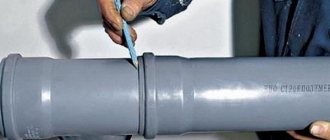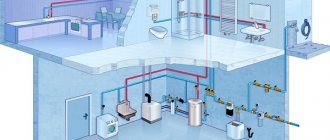Home/Water supply and sanitation/Replacement of risers in apartment buildings
Despite the fact that most residents are the owners of their apartments and pay for general building needs on a monthly basis, direct replacement of risers and other water supply elements is carried out by representatives of the management company (MC). Their actions are based on the regulatory framework of the laws of the Russian Federation. However, not many apartment owners know their rights if it is necessary to replace common communication elements located in their apartments.
The solution to replacing risers in an apartment building, the identification of responsible persons and the rules of behavior in conflict situations will be given below.
Attention! If you have any questions, you can chat for free with a lawyer at the bottom of the screen or call Moscow; Saint Petersburg; Free call for all of Russia.
Normative base
The regulatory framework for the replacement and repair of the water supply system is regulated by:
- rules for the maintenance of property located in the common possession of the apartment building (RF RF No. 491 dated 08/13/20016);
- standards for the technical use of housing stock (Resolution of the State Construction Committee of the Russian Federation dated September 27, 2003 No. 170);
- methodological manual for the operation, maintenance and repair of housing stock MKD 2-04.2004.
Who should change risers in an apartment building?
It is a mistake to believe that if the common water risers are used by the residents of the apartments of an apartment building, then the responsibility for replacing them rests entirely with them. Ignorance of the regulatory framework of the Housing Code leads to unnecessary waste of money from the pockets of owners.
Attention
Decree of the Russian Federation No. 354, Article 149 (dated May 6, 2011) and Article 161 of the Housing Code of the Russian Federation state that repairs, as well as complete replacement of risers in an apartment building, are the responsibility of the Management Company assigned to a specific building.
Every month, each apartment owner receives a receipt for utility bills, which contains the column “maintenance and repairs.” For those funds that come from residents from paying receipts, in particular for maintenance and repairs, all preventive and repair work must be carried out.
Consequently, in the event of a pipe break or other damage to the riser, the housing office is obliged to carry out repair work without charging residents (the reverse action is illegal).
Practical advice
- Why do fistulas occur on pipes and how to eliminate them?
A fistula indicates through-corrosion of the water supply system. Fistulas most often appear on welds (at a pipe connection or a longitudinal seam: all water and gas pipes according to GOST 3262-75 are produced by welding a flat piece).
Fistula on a steel heated towel rail
A single fistula can be eliminated without welding by installing a bandage made of a rubber gasket (for example, for a crane box) and a clamp or knitting wire. If there are a large number of fistulas, the problem area of the liner or riser must be replaced.
Bandage from a collar
- Is it necessary to change the riser in the ceiling?
If there is at least some opportunity for this, it is necessary. Steel pipes rust most quickly inside the cement-sand seal of the ceiling.
Correct replacement of risers: pipes are passed through the ceiling
- How to make the transition from a steel pipe to a fitting for connecting metal-plastic or polypropylene?
This can be done in three ways:
- Weld a threaded pipe to the cut riser;
- By cutting the thread manually, using a die or die;
To install the adapter on the steel riser, a thread is cut
- By installing a compression fitting adapter on a smooth pipe.
Installing a compression fitting on a smooth steel pipe
Important: in the latter case, the end of the pipe must be thoroughly cleaned of paint and rust.
- Why do you need reinforcement of polypropylene pipes and is it worth buying reinforced pipes to replace a riser or liner?
Reinforcement with fiber or foil increases the pipe's resistance to hydrostatic pressure and, more importantly, reduces its elongation with increasing temperature. Heating by 50 degrees causes each meter of unreinforced pipe to become 7 mm longer. Fiber reduces elongation to 3 mm, foil to 1.5.
Aluminum pipe reinforcement
For comparison: a steel pipe under the described conditions elongates by 0.5 mm.
Reinforcement is preferably done in hot water. You can safely install unreinforced pipes on cold water pipes.
The aluminum foil must be stripped at the end of the pipe before welding it to the fitting
- Why do plastic hot water risers become deformed and how to avoid this?
Hot water riser bend
The reason is the notorious elongation of pipes when they are heated. The problem is solved by installing ring or U-shaped compensation bends; in this case, the clamps closest to the compensator should provide sliding fastening of the pipe.
Risers with ring expansion joints
- Why do connections on metal-plastic leak?
Location of the leak - connection between the fitting and the pipe
Exclusively due to gross errors during the installation of compression and (less often) press fitting connections. The pipe must be cut only with a pipe cutter and must be calibrated. In addition, the internal chamfer must be removed from its end.
Correct execution of the operation: the pipe is cut with a pipe cutter and calibrated
Tip: Many calibrators are equipped with knives that chamfer during calibration.
Valtec Universal Calibrator
If a metal-plastic pipe is cut with a hacksaw or grinder and retains the ovality acquired when coiled, the following happens when assembling the joint:
- The uneven end of the pipe, when put on the fitting fitting, pulls out the elastic sealing rings from the grooves and moves the elastic sealing rings towards the fluoroplastic washer;
The photo clearly shows the o-ring on the fitting
- Instead of a sealant, the pipe is crimped directly onto the brass fitting;
- When heated, the fitting expands, and the increased pressure squeezes the softened plastic of the inner shell of the pipe out of the space between the fitting and the aluminum core;
- When cooled, a leak occurs between the fitting and the core.
It’s interesting: in cold water, metal-plastic forgives installation errors due to its stable temperature conditions and the absence of expansion-compression cycles.
Replacement standards
According to the standards for replacing risers in an apartment building, they must be replaced in two cases:
- Expiration of the operational life of the metal structure.
- Complete renovation of the apartment's bathroom.
Living conditions provide for 2 modes of pipe replacement:
- planned - when the time for replacement has approached;
- emergency - when the integrity of the pipe has been damaged and a leak has formed.
IMPORTANT
The warranty period for pipes in apartment buildings is at least 25 years. Even if after this period the structure is intact without leaks, the riser still needs to be replaced.
Increasingly, cast iron pipes are being replaced with polypropylene ones. This is due to a number of advantages of the material:
- efficiency;
- ease;
- strength;
- environmental safety;
- resistance to deformation from thermal effects;
- resistance to corrosion and other influences;
- sliding structure of the internal walls, which prevents plaque formation;
- long service life: from 50 to 100 years.
What is included in replacing risers in an apartment building?
The process of replacing a riser in an apartment building is the direct removal of the old structure for a new one. However, this is not all that is included in the concept of “replacing a riser in an apartment building.”
Attention
First, you need to contact the management company and write an application to replace the pipe. The applicant will receive a satisfactory answer if the document is drawn up correctly and the facts supporting it do not raise doubts.
On the appointed day, representatives of the management company turn off the water in the risers and drain the remaining water. After this, craftsmen come from the management company or organization with which the management company has entered into an agreement. They carry out all the necessary procedures for replacing a faulty riser pipe in an apartment building.
- The master uses a grinder to cut out old pipes.
- Makes markings for new branches.
- New pipeline structures are being installed.
- They run water to check the tightness of all joints of the new riser.
By law, all necessary elements of the communication system that need to be replaced are delivered to the owner’s apartment. However, situations are not uncommon when the tenant himself, in whose apartment the installation is to be carried out, pays for all consumables and the element of the new pipe itself. By law, all expenses of the owner must be included in the payment of the receipt for the maintenance of common property for the next month.
Features of connecting to the wiring
In the place where the vertical pipeline will connect to the wiring in the apartment, install a tee measuring 32/20/32. To facilitate installation of the tee, its end is lubricated with liquid soap. The elements are fixed by soldering.
When planning to install a heated towel rail in the bathroom, two additional tees are installed on the pipeline
An important point: when installing tees, it is preferable not to use a coupling, but a soldered connection.
After installing the shut-off valve, check for leaks. If there is none, fix the assembled structure to the wall.
To do this, using a building level, pre-mark points in the wall for making holes for installing clips. Fastening elements are placed every 100-150 cm.
From the moment the last connection is made, the installed section of the network can be filled with water no earlier than an hour later. To ensure a sufficient level of moisture resistance and sound absorption, the places where pipes pass through the ceilings are concreted throughout the entire thickness. These and other finishing activities are carried out only after testing the structure.
Step-by-step instructions for replacing risers in an apartment building
A break in the water riser in one apartment requires its immediate replacement. Before carrying out repair work, the owner of an “emergency” apartment must discuss this action with the neighbors of the upper and lower floors. The fact is that the pipes are in a worn state along their entire length, despite the fact that the breakthrough occurred in a certain place. And for reliability, they should be replaced completely, in all apartments. If the neighbors disagree, the installation of a common water supply channel will be carried out only in one apartment.
The next step is to contact the Criminal Code. Their powers include shutting off the riser and draining the water. Next, complete or partial (in a separate apartment) installation of pipes takes place.
According to VSN 58-88 (r) “On the organization and implementation of reconstruction, repair and maintenance of buildings, public utility and social-cultural facilities,” planned replacement of water supply systems should be carried out every 25-30 years. Repair work is carried out inside privatized and non-privatized apartments, as well as in basements and entrances.
Water
The water supply riser is technically clearly identified: up to the first shut-off valve, pos. 2 and 3 in Fig. However, in modern new buildings at the budget level and monolithic boxes with an open plan, this clarity is often violated: developers do not install common shut-off valves for the apartment. This is bad in all respects, and most importantly because of the risk of accidents, so you need to install the valves yourself. Formally, for this you need to declare to the Criminal Code indicating the time of work; Permission will be given only upon payment for the downtime of the riser. The amount will be considerable, so it’s better to simply agree with your neighbors at what time they will agree to be left without water for half an hour or an hour, prepare materials and tools in advance, shut off the riser in the basement and install the valves with your own hands. How to navigate the communications in the basement, see for example. video below.
Video: searching and identifying communications in the basement
In high-rise buildings with water pumping to the upper floors, two difficulties are possible here. First - what kind of boner is yours? Management companies are required to provide communication wiring diagrams in a building to residents upon requests from municipal technical services, real estate agencies, and mortgage lenders. Simply at the request of the tenant - no. Justification is access to vital systems. Secondly, under no circumstances should you shut off the riser coming from the pumping system or turn off the pump at random: the pipes may burst due to water hammer, and then you will suffer a lot of grief. The solution is to find out which uncle Vasya or guy Petya in the housing office or service company is engaged in pumping and negotiate with him to disconnect informally. There will be fewer expenses and hassles.
The second series of organizational issues arises due to the fact that the riser pipes stick to the ceilings. This is especially true for steel cold water risers, because... During the heating season they often sweat. As a result, in order to free the pipe, you have to remove the finishing of the floor and ceiling within a radius of 10-20 cm from it. Here, issues will have to be resolved not with the authorities, but with the neighbors, see below.
Replacing a sewer riser
The sewer riser belongs to the common property of the house, even though it passes through a private apartment (according to Article 290 of the Civil Code). Also, the RF PP No. 491 clause 5 dated 08/13/2006 states: “... the common property includes the drainage system, that is, the sewerage system...”.
Consequently, the management company is responsible for the installation and repair work of the sewer riser in an apartment building. For all the necessary consumables that will be required during the replacement process, as well as for the repair itself, apartment residents pay for it, paying monthly sums of money for receipts with the column “maintenance and repair of housing.”
IMPORTANT
On the day the sewer riser is replaced, the apartment owner does not have to pay anything.
But, if previously the owner of the apartment independently replaced the sewer pipe, and this fact is proven, then the owner is obliged to fully pay for the subsequent installation of this element of the communication system.
Before starting repairs to the sewer riser of an apartment building, a resident must:
- Visit the management company and leave an application for replacement of the emergency element.
- Draw up a report with a representative of the service organization, which will describe the condition of the sewer riser and (recommended) attach a photo.
- Specify the date and time of the work to be carried out, and notify neighbors about it in a timely manner.
- Determine the material of the structure that will be installed in place of the old one, as well as some nuances.
At the appointed time, repairmen come and carry out all the necessary actions to replace the sewer riser.
For your information
Upon completion, a “Certificate of Work Completed” is drawn up between the management company and the repair organization. The owner of the apartment should also keep a copy of this act.
Tips for those who want to replace the sewer riser along with the water supply riser
Changing the sewer system pipes in an apartment requires calculations that are somewhat more complicated. Note that dismantling in this case is not easy. However, the assembly of new structures is still faster than pipes with cold/hot water. After all, the drain pipes are connected through a socket using a sealing ring, so there are no particular difficulties in this operation - except that the work itself will be somewhat dirtier than when replacing water pipes or heating systems.
Replacing sewer pipes in an apartment consists of three steps:
- Initially, you will need to update the siphon elements that are located under the sinks. Next, calculations are performed to determine the slope of the pipes that connect the riser and siphon. Slope refers to the difference in height above the floor between the entrance of the pipe and its exit. The entrance is located under the siphon itself, the outlet part is on the tee of the fan riser. This height difference is directly determined by the length of the pipe.
As a rule, a pipe with a diameter of 5 cm is laid with a slope of 2.5–3.5 cm per linear meter. After determining this value, it will be necessary to project the dimensions onto the surface, which will serve as a support for the planned sewer pipe. To do this, draw the position of the branch directly on the wall. Next, you can begin dismantling the old drain pipes.
- You will need to remove the fan riser, having first blocked it. When removing, a pneumatic plug is inserted into the collapsible end of the riser revision; it will act as a plug from the neighboring drains. After this, you need to extremely carefully caulk the central tee - it is responsible for connecting all the drain pipes in the apartment. After this, they get rid of the old pipes; this operation does not require any special actions. If these are cast iron products, they are simply hit with a hammer and the broken parts are thrown away.
- Then you need to assemble it. First, a polyvinyl chloride pipe is installed. It is responsible for connecting the toilet flush and a tee with a diameter of 10 cm (cast iron). Next, drain pipes leading from the sinks and bathtub are connected to the tee. Their diameter is 5 cm. The operation is simple - the smooth end of the pipe is connected to the socket.
After this, the revision is freed from the plug, and the riser itself is hermetically sealed by simply screwing on the caps. At this point, the replacement of sewer pipes is considered complete, and the new drainage system is ready for use.
Cooperating with is reliable and prestigious. The specialists working here are professionals of the highest level. operates throughout Moscow and the Moscow region.
Payment for replacement
The answer to the question regarding payment for replacing a riser in an apartment building is contained in Government Decree of the Russian Federation No. 491 dated August 13, 2006. The document determines what is common property, who is responsible for its maintenance and accordingly pays for its repair and replacement.
According to PP No. 491 and its section “Rules for maintaining the property of an apartment building,” each apartment owner pays for the maintenance and repair of all communications in the building. The same information is contained in Article 158 of the Housing Code of the Russian Federation “Expenses of owners of premises in an apartment building”: all owners of apartments in apartment buildings are involved in the costs of maintaining and repairing common property.
Thus, all costs for replacing the water supply riser in an apartment building are paid by the housing and communal services from the funds that all apartment owners contribute monthly, depositing money for receipts for the maintenance of common property.
What documents are issued to the property owner?
Upon completion of the installation of the MKD water riser pipe, a “Certificate of Work Completed” must be drawn up, which will state the following:
- date of drawing up the contract;
- serial number of the agreement according to which the act is issued;
- the volume of work performed and all actions taken;
- cost of work;
- name of the person performing the repair work;
- signatures of the contractor and the customer.
This document is made in 2 copies, one of which is given to the contractor, and the second remains with the customer. The contractor is the organization that replaces the damaged element. The customer can be the management company (in which case one copy remains with them and is not given to the owner of the apartment) or directly the owner of the property.
Even if the agreement was drawn up by a representative of the management company and the repair company, the apartment owner should make himself a copy of this act.
Cost of work
The price of the work depends on the type of piping, the scope of work and the materials used. In the standard case described above, for large cities in the central part of Russia, the cost starts from 3,000 rubles for 1 riser and 1 floor.
This is the cost excluding materials, but including the cost of dismantling pipes. Costs for materials can range from 1,000 rubles, without shut-off valves, and up to 2,000 rubles with taps.
Table with costs:
| Name | Purpose | quantity per 1st floor | unit price RUR | total cost RUR |
| Pipe d 32 mm, meter | supply riser | 3,0 | 85 | 250 |
| Pipe d 25 mm, meter | reverse riser | 3,0 | 50 | 150 |
| Sleeve, pcs. | into the ceiling | 2 | 20 | 40 |
| Tee 32x20x32, pcs. | transfer to the apartment | 1 | 30 | 30 |
| Tee 25x20x25, pcs. | heated towel rail | 2 | 15 | 30 |
| Connector with American, pcs. | 1 for input and 2 for drying | 3 | 120 | 360 |
| Consumables | mortar, sealant, etc. | 130 | 130 | |
| Total materials | 990 | |||
| Drying taps | heated towel rail | 2 | 350 | 750 |
| Total | 1740 |
Reference! In total, replacing a hot water riser can cost from 4,000 to 6,000 rubles per apartment.
Is it possible to refuse to replace risers in an apartment building?
“Is it possible to refuse to replace the riser?” - a pressing question for those residents who have undergone a major renovation of the apartment, because the proposed general house procedure implies some damage to the owner’s property in the bathroom. Is it possible to write a refusal?
Based on the information contained in clause 5 of PP No. 491, risers in apartment buildings are common property. According to the law, none of the residents has the right to prevent representatives of the contractor (MC), as well as emergency services, State control and supervision authorities from inspecting the current condition of communication equipment and carrying out repair work. A control inspection should be carried out no more than once every 90 days, and in case of an emergency - at any time.
Thus, apartment owners do not have the opportunity to refuse to replace common communication systems in an apartment building. In response to the refusal, the management company or HOA has the right to sue.
Possible conflicts and their resolution
When replacing a riser in an apartment, its owner may encounter situations that prevent repair work . Conflict cases may be as follows:
- Refusal of the management company to replace faulty equipment.
- Neighbors disagree with replacing the riser in an apartment building.
There is no point in delaying their decision, especially if replacement of the emergency element is required in the very near future.
When contacting the management company with an application to replace the riser in an apartment building, you may encounter a refusal to carry out the work. The reasons may be different, but most often the management organization refers to the serviceability of the communication system. In this case, the owner has every right to sue the management company, as well as to recover monetary compensation from them for the damage caused.
A common emergency pipeline often leaks not only in one apartment, but also in neighbors above or below. Or the riser is in unusable condition and requires a total replacement, and not just a separate “fragment”. Therefore, installation should be carried out in several apartments. But there are often cases when some of the owners refuse to carry out the necessary work.
It is possible to solve the problem through conversations, but they do not always lead to the desired result. In this situation, the best solution would be a trial. But it is not other apartment owners who must apply to the court, but the management company. In his application to the judicial authorities, the representative of the management company puts forward a demand to the court to force the owner to replace the riser.
For your information
Litigation is not a quick process, but it is effective. According to his decision, the owner obstructing the repair undertakes not only to allow repairmen to replace the pipe, but also to install the concealing box (if there is one). The judge can significantly speed up the process of the case by satisfying the plaintiff’s request in accordance with Art. 212 of the Civil Procedure Code.
Dismantling diagram
If you follow all the rules for dismantling, it will go without problems. They start by making cuts with a grinder. The first is done at a distance of 10 cm from the ceiling, the second - at a height of 1 m from the floor. The lower incision is made not circularly, but in a spiral. This is necessary so that the weight of the pipe does not jam the cutting wheel. They go over the cut made with a chisel, hitting it with a hammer. Then carefully tap the cut with only a sledgehammer - the pipe should burst along it.
They free the riser from its fastenings, acting according to the circumstances: cutting, cutting down, breaking. Remove the pipe.
A section of the riser is removed from the socket. They were sealed with an impregnated cord or filled with sulfur. With the first method, the pipe comes out without much effort if you hit it with a rubber hammer and lightly swing it. The end of the packaging rope is grabbed with pliers and pulled out little by little to facilitate dismantling.
If the sealing is done with sulfur, removing the riser from the socket is problematic. Such techniques as in the first case can lead to the destruction of the pipe of the neighbors below. Take a blowtorch or gas torch and heat the connection well. The sulfur mass softens, now the pipe is loosened and removed. To work, you will need a gas mask, because the fumes generated by heating sulfur are poisonous.
It is important that the riser comes out without bursting. If this happens, take a large flat screwdriver and widen the gap between the socket and the remains of the riser. Solvent is poured into it. After a few minutes, they begin to tap the pipe with a hammer through a wooden block, trying to swing it. The seal is gradually removed from the gap, freeing the tee from it.
The socket is cleaned of sealant residues using a chisel. When solid particles are removed, the inner surface is cleaned with a metal brush and sandpaper. It is important that it is smooth. This is necessary for a quality connection with a plastic pipe.
If it becomes necessary to dismantle the pipe from the ceiling, the consent of the neighbors is required. Use a hammer drill and clear the technological hole. After the work is completed, it is filled with polyurethane foam.
Complaint about poor quality replacement of risers in an apartment building
If the emergency riser is replaced poorly, the apartment owner has the right to file a complaint against the organization responsible for this matter. The complaint is submitted in writing to the State Housing Inspectorate of a specific region of Russia. It indicates the name and address of the owner where the emergency water riser is located.
The complaint consists of a statement and a request. The application must refer to Art. 161 of the Housing Code of the Russian Federation “General requirements for the management of an apartment building” and indicate that the repair work did not eliminate the emergency situation. The petition contains the applicant’s request to oblige the management company to correct the problems in accordance with the standards.
It would not be amiss to attach to the complaint photographic materials proving poor quality work, as well as an act drawn up between the tenant and the management company.











